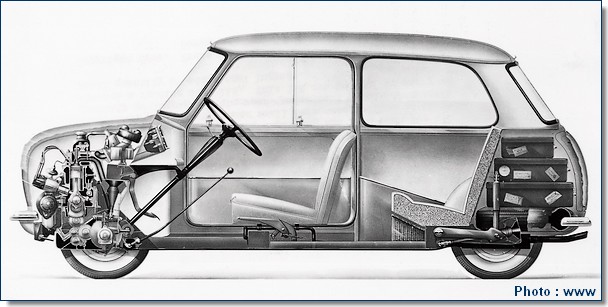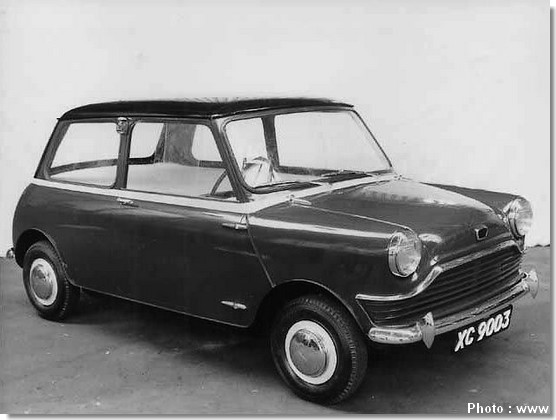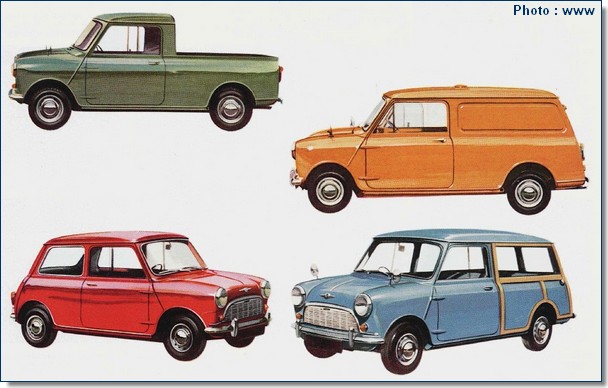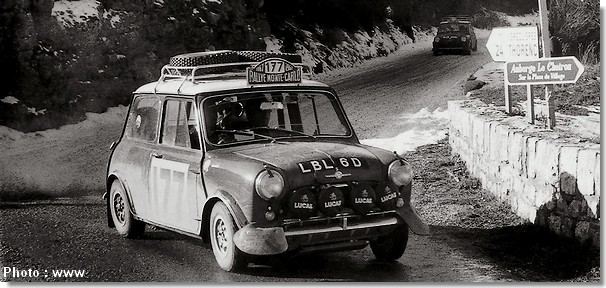|
|
|
The Mini inspired by Gabriel VOISIN
?
|
|
"...throw to the scrap what you found and buy
an AUSTIN with transverse engine..."
Gabriel Voisin May 1960 |
| Obviously nothing proves that engineers of BMC really visited Gabriel Voisin to examine his Biscooter during or before the study of Morris Mini Minor / Austin Seven, even if we can find a few common points between these two vehicles. |
 |
|
Specifications are close, Voisin's idea was the creation of a small economic transport during the period following WWII, the population misses financial ressources and the fuel was extremely expensive. For BMC, it was necessary to develop a small vehicle which will help to stand the effects of the Suez channel crisis, and its petrol rationing, at least for the subjects of Her Majesty. |
 One of the Mini prototypes |
|
And that was Sir Leonard Lord ( BMC chairman during the 50's) challenge to Alec Issogonis: to develop in two years a four places small automobile, economic at the purchase and in consumption. With a minimal budget, it is out of the question to develop a new engine for this car. And, logically the propeller of Morris Minor is choosen by the engineer and his team. On the other hand this car must be compact, but her occupants must have the maximum of space. To get this "livable" space, Issigonis decide to create a front-wheel drive car, to place the engine transversely ( a world premiere! ) and to integrate the gearbox in it. All the freed space allows to allocate to the passengers and to their luggage 80 % of the volume of the automobile. So the engine will be the modified Morris Minor (948 cc-37CV). At the final, the eight / power ratio is so good that the prototype exceeds 145 kph, what countered hardly reasonable for the frame and the brakes of the automobile. And It is decided to decrease the capacity of 100 cc, the engine does not deliver more than 34CV, giving a completely suitable speed of 120 kph. The economic side is the main problem and it is visible on the whole project, even on the body. Sheet steels are folded up towards the outside allowing a simpler, and thus cheaper, weld method. |
|
Same thing for the interior, minimalist. No real dashboard but a small central console, including a speedometer and a fuel gauge, framed by two huge glove compartments. Under this console are the only available commands: starter, ignition of lights, and a couple of switches. No handles, only a simple cable, no heating, it was only optional, even on "high-end" model, which nevertheless benefited from an ashtray, a carpet and leather parts on seats... |
 Saloon, woody, pickup and van, variants as illustrated in the catalogue |
|
The continuation of the story is well known, a production spreading out over forty years ( 5 300 000 copies), a pleiad of more or
less interesting versions, an increase of capacity (until 1300 cm3), the adoption of disc brakes, then injection in 1992, and the most eloquent racing palmares.
|
 |
|
In brief, a small transport, at first sight rustic and economic out of necessity, but technically innovative. I don't know about you, but it remind me the profile of the Gabriel Voisin's Biscooter create at the beginning of the 50s.
|
|
|